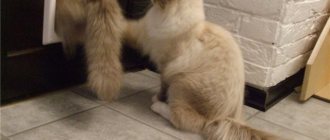Can a cat and a dog be friends?
I can say with confidence that peaceful relationships between animals are indeed possible. Much depends on their temperament and the owner’s ability to teach their pets to behave correctly with each other.
In terms of devotion and level of trust, the cat-dog relationship can become similar to the human concept of friendship. By the way, in dogs, loyalty to the owner and other individuals is much higher, while cats are driven by more selfish motives. One study found that during contact with living beings, dogs release more happy hormones than cats.
I have read articles by animal psychologists who explain that attachment begins with the desire for animals to be nearby and to use the skills of another to their advantage. For example, a cat can throw food off the table for a dog, and the dog will act as a protector on the street. But not all pets are ready for peaceful coexistence.
It is easiest to make friends with puppies and kittens, because they will grow up together, and the owners will have enough time to instill communication skills. The optimal age for kittens is up to 6 months, for puppies – up to 1 year. Interesting statistics: if a dog is adopted as a second pet, its attitude towards the cat becomes friendly in 75% of cases, and the order of adoption has almost no effect on the cat.
Introducing a cat to a puppy is relatively easy, especially if you have a female. Sometimes they mistake puppies for their children and are especially patient with the baby’s games. It is more difficult to introduce adults to already established behavior.
Why are animals not friends?
Before we strive to make friends with pets, we must recognize that not everything depends on the owner, and some animals will not live in peace and tranquility, no matter how much we want it.
Let's be honest: not all cats are sociable and react calmly to strangers and other pets. If a stranger appears in the house, the cat hides or defends itself.
Some dogs are poorly socialized and unfamiliar with cats. They may meet cats on the street while walking and try to play with them, but such a reaction is unlikely to meet with the approval of the pet.
Cats that grew up alone and are used to being dominant in the home may attack a small puppy.
Be prepared for this scenario and take care that the dog and cat are not harmed during communication.
How to choose the right breed
If you want to add a new member to your family, it is useful to learn more about the characteristics of purebred animals and their ability to get along with other individuals.
Dogs of hunting breeds do not favor small animals and often show aggression towards cats. Fox Terrier, Beagle, Russian Hound, Jack Russell Terrier love to hunt “game”. It is best to take them as puppies and raise them in the presence of an adult cat.
A British cat can be absolutely indifferent to a new resident, but sometimes behaves aggressively if the boundaries of its territory are violated. Be prepared for the fact that Persians, despite seeming calm, can scratch a dog’s delicate nose with their claws.
When choosing an animal from a breeder, ask about the pet’s character and how well it gets along with other animals. Usually breeders are attached to their babies and care about their safety, so they won’t cheat.
Outbred animals, especially those taken from the street, are calmer in relation to other individuals, but the acquaintance and life of animals together will improve more quickly if the owners take care of this, rather than leaving everything to chance.
Cat and dog in the same house: how to make friends with pets
“Like a cat and a dog” or “friends forever”? This article will help you learn how to make friends with your pets.
There are people who are incorrigible cat lovers, and there are equally incorrigible dog lovers. And between these two groups of animal lovers, disputes often arise about which of the pets is better to have, which of the two pets is kinder, smarter, more affectionate, etc. Such disputes can already be classified as eternal.
And there are people who do not participate in such discussions for the simple reason that they cannot classify themselves as either a dog person or a cat person: they belong to both.
It is about the third type of people, or more precisely about their pets, that we will talk today.
Animal Meeting
Moving to another place of residence is stressful for any living creature. Before introducing the new arrival to the other residents of the house, give him time to get comfortable. To do this, free up as much space as possible where he will not meet other animals, and give him the opportunity to calm down. The animal may hide, not make contact, and even refuse food. Sometimes this behavior lasts for several days. When you see that the new resident of the house has already settled down, start getting acquainted with other family members.
Offer to sniff the other animal's toys or things. The reaction may vary: if the dog reacts aggressively to the smell of the cat, you should be careful when introducing them.
The meeting of animals should take place in a limited space, for example, a closed room. Remove all glass objects and make sure there are no extraneous loud sounds. Place the cat in a closed carrier and keep the dog on a leash. Animals must see each other, but the distance between them must be decent. Enlist the help of one more person.
Before introducing yourself, take your dog for an active, long walk - this will use up his strength and reduce his activity.
Take turns feeding your dog and cat with one hand. It is important that animals see each other! For them, this will mean that they are not deprived of food in the presence of another animal, which means that nothing threatens their safety and survival. During this time, you can pet your pets and also talk to them affectionately.
It will be useful to meet in the presence of a dog handler, who will adjust the situation and help carry out the procedure competently.
After this, try letting the cat out of the carrier while continuing to keep the dog on a leash. The cat can stay in your arms for a while: pet it, and let your assistant pet the dog. Release the cat on the floor - it will probably want to walk around and sniff its future neighbor.
If the dog jerks towards the cat, restrain it in the manner that is customary for you. The command “fu” works best.
The relaxed state of the dog and cat, both physical and emotional, will indicate that the acquaintance was successful.
Don't be upset if the first attempt was a failure and your pets got nervous. This is fine! Repeat the procedure periodically until you see a weakening of the nervous reaction.
If your cat is too scared, read my article on how to calm your cat.
Cohabitation
When a cat and a dog are relaxed in each other's presence, we can assume that the acquaintance was successful. After this, try taking the leash off the dog and letting the pets go for walks together.
Even if the first stage is completed, you should not forget about safety measures and rules of living together. Aggression sometimes manifests itself unexpectedly from any side. The reason may be the problem of dividing territory, food, security, or fear of pain. Animals sense when they are being “bowed in” and will continue to behave inappropriately if action is not taken.
Nutrition
Most conflicts between pets arise due to food aggression. They actively defend their right to food and will seek primacy in this matter. I was able to eliminate this type of aggression by separating feeding areas.
You can feed animals in the same room, but in different areas. This way they will see that none of them is deprived of the owner’s care. Each pet should have its own bowl for food and water. It is best to feed at a certain time and remove the bowls after that so that the dog does not decide to eat his neighbor's food.
Rest
The struggle for territory is in second place on the list of conflicts. The struggle for a place near the owner can be especially fierce. Some pets love to take over their neighbor's bed, and this is not a problem if the animals get along well together. But more often the owner’s intervention is required, especially at first.
The pet cannot be the leader in the house; the owner always remains in charge. And if he stops territorial encroachments, then the animals will feel safe.
I recommend that you consider having your cat live at a higher elevation. Check out my article on how to make your own cat house. This is not difficult and will definitely not attract the dog, so the issue of territorial conflicts will be minimized.
Entertainment and communication
The dog receives more attention from the owner because it requires more care. A cat may feel a lack of affection, attention and entertainment, especially if there is another pet in the house.
A good way to make friends between a cat and a dog is to involve them in joint games where you will be in charge and can set the rules. Animals will see that they are treated equally, but no one should be offended.
When you have absolutely no energy to be active with your pets, try not to drive them away from you during passive rest. Proximity to the owner is very important for our four-legged friends, and if one does not receive enough attention, then conflicts on this basis are inevitable.
Common Mistakes
Inexperienced owners often do not know what to do in a given situation, which leads to the following mistakes:
- Poor nutrition: if everyone eats at the same time and nearby, then someone will inevitably try to steal food from someone else’s plate.
- Uncontrolled first meeting: some let the cat and dog communicate freely, not thinking that this could develop into a fight.
- Lack of separate resting places: cats are introverts by nature. Long communication will infuriate the pet and can lead to aggression. It is advisable to give the cat its place on a hill.
- Playing off animals: they will remember a fight that happens once for the rest of their stay, so clashes should not be allowed.
When to take action
Friends, let's be realistic: sometimes peaceful coexistence between pets is impossible. If a dog regularly tries to attack a cat, and the cat constantly scratches the dog, it is worth taking action.
For dogs, the owner is the authority, and a good way to keep him in line is to remind him of the rules of behavior. Training will help with this. If you have already completed it, it is worth repeating or teaching new commands so that the authority of the owner prevails over instincts. But you need to be extremely careful and understand that at some point you will not be around and the animal may react to the cat.
When you leave home, be sure to place your pets in different rooms or place the dog in an enclosure.
Prohibited actions
Friends, there are rules that are very important for animals living together. Remember them and teach them to your children.
- Never pit your pets against each other.
- Don't encourage aggressive behavior.
- Do not practice commands on another pet.
Failure to follow these rules will lead to uncontrollable behavior of the cat and dog, for which you will be to blame.
An equally important aspect: if the animal is sick, be sure to isolate it from other pets. Unfortunately, instincts can play a cruel joke, and the dog will perceive a weakened neighbor as a victim.
What should you avoid?
- It is advisable not to take an excitable dog into a house where a timid and fearful cat lives. In this case, the cat is guaranteed chronic stress and subsequent problems - both behavioral and health. And a “fun” life awaits you.
- You should not take a kitten to an older dog. Dogs become quite irritable in old age, as they often feel bad and are not ready for the advances of a young naughty person. Take pity on your faithful friend and protect him from such trials.
- It is not the best option to take a cat into a house where there is a dog with a strong hunting instinct. Such a neighborhood could end in tragedy.
- You should not bring into the house where a dog lives (or is planned) a cat that already has bad experience with dogs.











